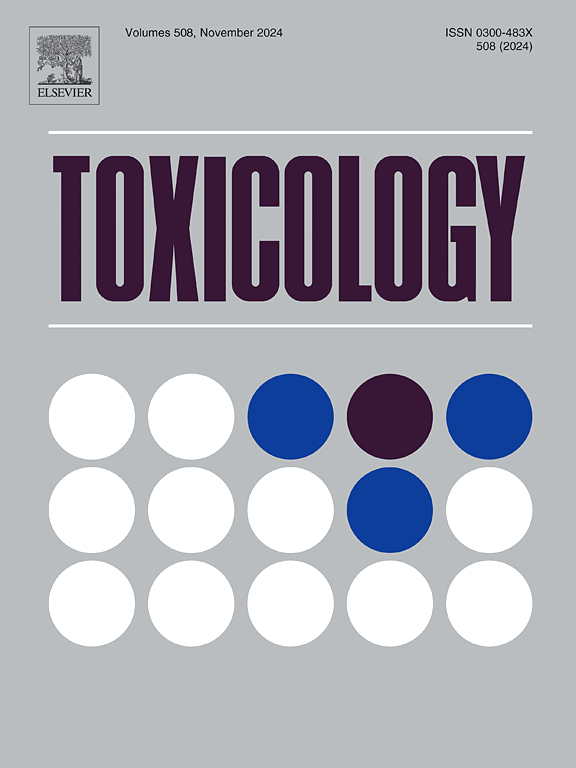PFAS化学物质3:3氟端粒羧酸、7:3氟端粒醇和全氟己胺的转录组剂量反应评估。
IF 4.6
3区 医学
Q1 PHARMACOLOGY & PHARMACY
引用次数: 0
摘要
全氟烷基和多氟烷基物质(PFAS)是一类不同的人为化学品,它们在制造业和商业中的广泛使用已导致这些化学品进入环境。由于缺乏关于大多数全氟磺酸钠的传统毒理学数据,在相对较短的时间内提供支持性信息以了解人类健康影响的新型测试方法将变得越来越重要。美国环境保护署(EPA)的转录组学评估过程(ETAP)最近由该机构实施,作为一种有效和具有成本效益的方法,开始评估缺乏传统毒性测试数据的化学品对人类健康的潜在影响。该方法包括对雄性和雌性成年大鼠进行为期5天的短期口服给药,然后在12个组织中进行转录组剂量-反应评估,以确定一个起点。ETAP起始点确定的剂量在此剂量下没有协调的转录变化,表明可能存在潜在的毒性。然而,这种方法并没有探索任何与危害或机制的具体联系。本文报告了三种PFAS化学物质的ETAP结果:3:3氟端粒羧酸(3:3 FTCA), 7:3氟端粒醇(7:3 FTOH)和全氟己胺(PFHxSA)。通过ETAP评估并按人体等量计量,与测试化学物质相关的转录组起始点分别为0.00235 (3:3 FTCA)、0.0152 (7:3 FTOH)和0.00358 (PFHxSA) mg/kg-day。本文章由计算机程序翻译,如有差异,请以英文原文为准。
Transcriptomic dose response assessment of PFAS chemicals 3:3 fluorotelomer carboxylic acid, 7:3 fluorotelomer alcohol, and perfluorohexanesulfonamide
Per- and polyfluoroalkyl substances (PFAS) are a diverse class of anthropogenic chemicals, and their widespread use in manufacturing and commerce has led to introduction of these chemicals into the environment. Owing to the lack of traditional toxicology data on the majority of PFAS, novel testing methods that provide supporting information to inform human health impacts in a relatively short time frame will be increasingly important. The US Environmental Protection Agency’s (EPA) Transcriptomic Assessment Process (ETAP) was recently implemented by the Agency as an efficient and cost-effective method to begin assessing potential human health impacts of chemicals that lack traditional toxicity testing data. The method involves short-term oral dosing in male and female adult rats over a five-day interval, followed by transcriptomic dose-response assessment in twelve tissues to determine a point of departure. The ETAP point of departure identifies the dose at which there are no coordinated transcriptional changes that would indicate a potential toxicity of concern. However, this approach does not explore any specific association with hazard or mechanism. Reported here are ETAP results for three PFAS chemicals: 3:3 fluorotelomer carboxylic acid (3:3 FTCA), 7:3 fluorotelomer alcohol (7:3 FTOH), and perfluorohexanesulfonamide (PFHxSA). The transcriptomic points of departure associated with the tested chemicals, as assessed via ETAP and allometrically scaled to human equivalent doses, were 0.00235 (3:3 FTCA), 0.0152 (7:3 FTOH), and 0.00358 (PFHxSA) mg/kg-day.
求助全文
通过发布文献求助,成功后即可免费获取论文全文。
去求助
来源期刊

Toxicology
医学-毒理学
CiteScore
7.80
自引率
4.40%
发文量
222
审稿时长
23 days
期刊介绍:
Toxicology is an international, peer-reviewed journal that publishes only the highest quality original scientific research and critical reviews describing hypothesis-based investigations into mechanisms of toxicity associated with exposures to xenobiotic chemicals, particularly as it relates to human health. In this respect "mechanisms" is defined on both the macro (e.g. physiological, biological, kinetic, species, sex, etc.) and molecular (genomic, transcriptomic, metabolic, etc.) scale. Emphasis is placed on findings that identify novel hazards and that can be extrapolated to exposures and mechanisms that are relevant to estimating human risk. Toxicology also publishes brief communications, personal commentaries and opinion articles, as well as concise expert reviews on contemporary topics. All research and review articles published in Toxicology are subject to rigorous peer review. Authors are asked to contact the Editor-in-Chief prior to submitting review articles or commentaries for consideration for publication in Toxicology.
 求助内容:
求助内容: 应助结果提醒方式:
应助结果提醒方式:


